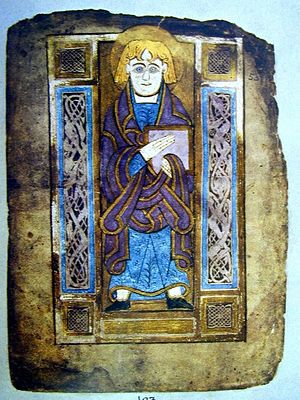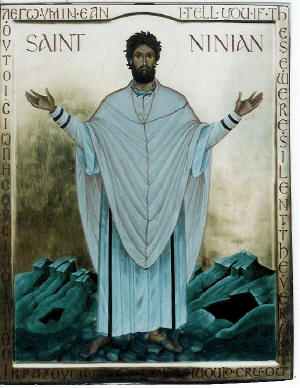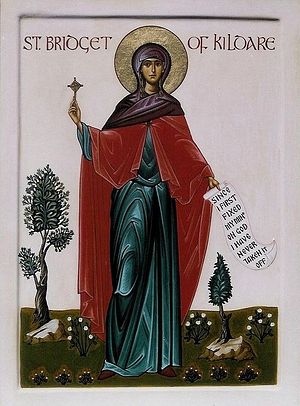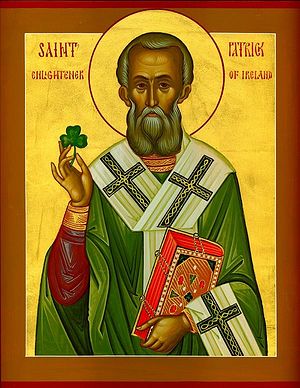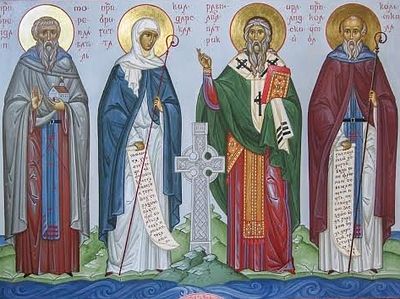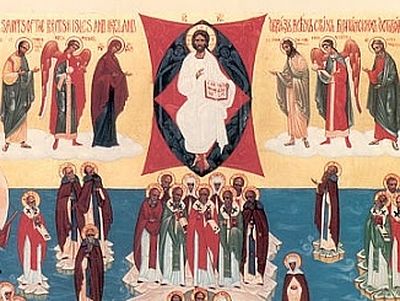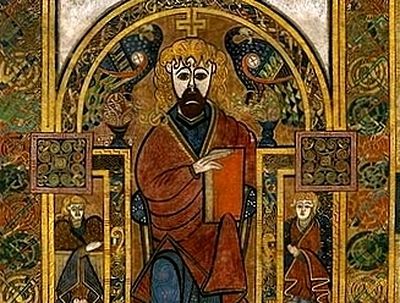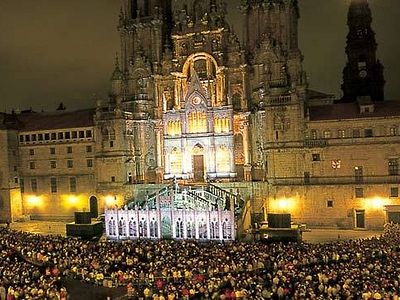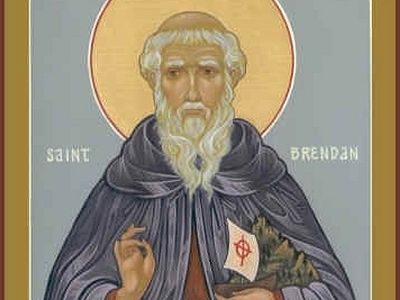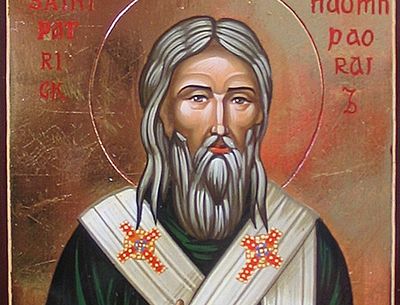On this (Julian Calender) St. Patrick’s day, historical for its first official ecclesiastical commemoration by churches of the Moscow Patriachate, with the poetic “ode to Celtic saints” by Monk Nicodemos.
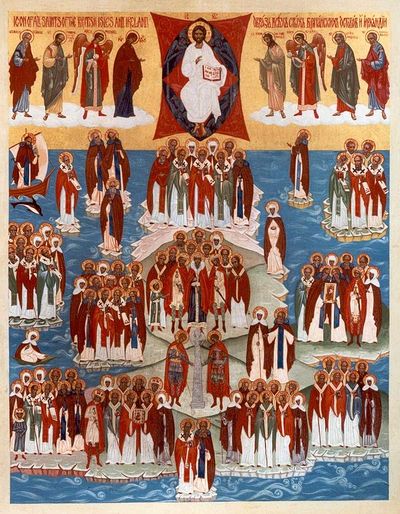 Icon of All Saints who shone forth in the lands of Britain and Ireland. Photo: Pravoslavie.ru
Icon of All Saints who shone forth in the lands of Britain and Ireland. Photo: Pravoslavie.ru 1. How Did Orthodoxy Reach Ireland?
How did Orthodox Christianity come to this small green island off the shores of the European continent in the uttermost West? Unknown to many, Christianity in Ireland does have an Apostolic foundation, through the Apostles James and John, although the Apostles themselves never actually visited there.
The Irish people were the westernmost extension of the vast Celtic civilization—whose people called themselves the Gauls—which stretched from southern Russia through Europe and eventually into the British Isles. The vastness of Celtic/Gallic civilization is evident in the names used to designate countries within its entire territory: the land of Galatia in Asia Minor, Gaul (France), Galicia (northwest Spain), and the land of the Gaels (Ireland). The Celtic peoples (like the Jews) kept in very close contact with their kinfolk across the Eurasian continent. When Christianity was first being spread by the Apostles, those Celts who heard their preaching and accepted it (seeing it as the completion of the best parts of their ancient traditions and beliefs) immediately told their relatives, traveling by sea and land along routes their ancestors had followed since before 1000 b.c.
The two Apostles whose teachings had the greatest influence upon the Celtic peoples were the brothers James and John, the sons of Zebedee. After Pentecost, James first preached the Gospel to the dispersed Israelites in Sardinia (an island in the Mediterranean Sea off the east coast of Spain, which was used as a penal colony). From there he went on to the Spanish mainland and traveled throughout the northern part of Spain along the river Ebro, where his message was eagerly heard by the Celtic/Iberian peoples, especially those in Galicia. This area continued to be a portal to Ireland for many centuries, especially for the transmission of the Good News.
John preached throughout the whole territory of Asia Minor (modern-day Turkey), and the many peoples living there accepted Christianity, including the Celtic peoples known as the Galatians (in Cappadocia). These people also communicated with their relatives throughout the Greco/Roman world of the time, especially those in Gaul. By the middle of the 2nd century the Celtic Christians in Gaul asked that a bishop be sent to them, and the Church sent St. Irenaeus, who settled at Lyons on the Rhone river. Among the many works St. Irenaeus accomplished, the most important were his mastery of the language of the local Celtic people and his preaching to them of the Christianity he had received from St. Polycarp, the disciple of St. John the Theologian.
By the 4th century Christianity had reached all the Celtic peoples, and this “leaven” was preparing people’s hearts to receive the second burst of Christian missionary outreach to the Celts, through St. Hilary and St. Martin.
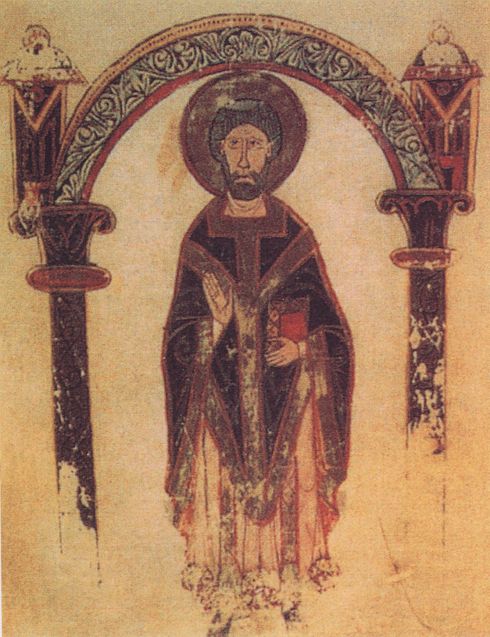 St. Hilary of Poitiers. Photo: Orthochristian.com
St. Hilary of Poitiers. Photo: Orthochristian.com The seeds that St. Irenaeus planted bore abundant fruit in the person of St. Hilary of Poitiers, who, having lived in Asia Minor, would be the link between East and West, transmitting Orthodoxy in its fullness to the Celtic peoples. He was not only a great defender of the Faith, but also a great lover of monasticism. This Orthodox Faith and love for monasticism was poured into a fitting vessel—Hilary’s disciple, St. Martin of Tours, who was to become the spiritual forefather of the Irish people. What Saints Athanasius and Anthony the Great were to Christianity in the East, Saints Hiliary and Martin were to the West.
By the 4th century an ascetic/monastic revival was occurring throughout Christendom, and in the West this revival was being led by St. Martin. The Monastery of Marmoutier which St. Martin founded near Tours (on the Loire in western France) served as the training ground for generations of monastic aspirants drawn from the Romano-Celtic nobility. It was also the spiritual school that bred the first great missionaries to the British Isles. The way of life led at Marmoutier harmonized perfectly with the Celtic soul. Martin and his followers were contemplatives, yet they alternated their times of silence and prayer with periods of active labor out of love for their neighbor.
Some of the monks who were formed in St. Martin’s “school” brought this pattern back to their Celtic homelands in Britain, Scotland and Wales. Such missionaries included Publicius, a son of the Roman emperor Maximus who was converted by St. Martin, and who went on to found the Llanbeblig Monastery in Wales—among the first of over 500 Welsh monasteries. Another famous disciple of St. Martin was St. Ninian, who traveled to Gaul to receive monastic training at St. Martin’s feet, and then returned to Scotland, where he established Candida Casa at Whithorn, with its church dedicated to St. Martin. The waterways between Ireland and Britain had been continually traversed by Celtic merchants, travelers, raiders and slave-traders for many centuries past, so the Irish immediately heard the Good News brought to Wales and Scotland by these disciples of Ninian.
About the same time that the missionaries were traveling to and from Candida Casa amidst all this maritime activity, a young man named Patrick was captured by an Irish raiding party that sacked the far northwestern coasts of Britain, and he was carried back to Ireland to be sold as a slave. While suffering in exile in conditions of slavery for years, this deacon’s son awoke to the Christian faith he had been reared in. His zeal was so strong that, after God granted him freedom in a miraculous way, his heart was fired with a deep love for the people he had lived among, and he yearned to bring them to the light of the Gospel Truth. After spending some time in the land of Gaul in the Monastery of Lérins, St. Patrick (†451), was consecrated to the episcopacy. He returned to Ireland and preached with great fervor throughout the land, converting many local chieftains and forming many monastic communities, especially convents.
It was during the time immediately following St. Patrick’s death, in the latter part of the 5th century, that God’s Providence brought all the separate streams of Christianity in Ireland into one mighty rushing river.
While St. Patrick’s disciples continued his work of preaching and founding monastic communities—it was his disciple, St. Mael of Ardagh (†481), for example, who tonsured the great St. Brigid of Kildare (†523)—several other saints who were St. Patrick’s younger contemporaries began to labor in the vineyard of Christ. These included Saints Declan of Ardmore (†5th c.), Ailbhe of Emly (†527), and Kieran of Saighir (†5th c.).
Then came young Enda from the far western islands of Aran (off the west coast of Ireland). He studied with St. Ninian at Whithorn, and thus received the flame of St. Martin’s spiritual lineage with its ascetical training and mystical aspirations. Having been fully formed in the Faith, St. Enda (†530) returned to the Aran Islands, where he founded a monastery in the ancient tradition. It was on the Aran Islands that the traditional founder of the Irish monastic movement, St. Finian, drank deep of the monastic tradition established by St. Martin. Before Finian’s death in a.d. 548, he founded the monastery of Clonard and was the instructor of a whole generation of monks who became great founders of monasteries throughout Ireland, and great missionaries as well. The most famous of his disciples were named the “Twelve Apostles of Ireland,” and included Saints Brendan the Navigator, Brendan of Birr, Columba of Iona, Columba of Terryglass, Comgall of Bangor, Finian of Moville, Mobhi of Glasnevin, Molaise of Devenish, Ninnidh of Inismacsaint, Sinnell of Cleenish, Ruadhan of Lorrha, and the great monastic father Kieran of Clonmacnois. By the middle of the 6th century these men and their disciples had founded hundreds of monasteries throughout the land and had converted all the Irish. And that was only the beginning...
2. Why was Christianity Received so Quickly in Ireland?
Why were the Celtic peoples able to receive Christianity so readily and so eagerly? The Church Fathers state that God prepared all peoples before the Incarnation of Christ to receive the fullness of Truth, Christianity. To the Jews He gave the Israelite revelation. Among the pagans, faint foreshadowings of the coming revelation were present in some of their beliefs and best qualities. The Celtic peoples were no different—in some ways they were better off than most pagans.
On a natural level, the Celtic peoples had a great love of beauty which found overflowing expression as the Christian Faith, arts and culture developed in Ireland. Their extreme and fiery nature, which had previously been expressed through war and bloodshed, now manifested itself in great ascetic labors and missionary zeal undertaken for love of God and neighbor.
Their great reverence for knowledge, especially manifested in lore, ancient history and law, made it easy for them to have great respect for the ancient forms and theology of the Church, which were based in ancient Israelite tradition. They had a great love for, and almost religious belief in, the power of the spoken word—especially in “prophetic utterances” delivered by their Druid poets and seers.
These perceived manifestations of “the wisdom of the Other World” were held in great respect and awe by the Irish, as transmissions of the will of the gods, which could only be resisted at great peril. When many of their Druid teachers wholeheartedly accepted Christianity, and as Christians spoke the revealed word of God from the Scriptures or from the Holy Spirit’s direct revelation, the people listened and obeyed. The Irish possessed an intricate and detailed religious belief system that was primarily centered in a worship of the sun, and a tri-theistic numerology—often manifesting itself in venerating gods in threes, collecting sayings in threes (triads), etc.—which led to the easy acceptance of the true fulfillment of this intuition in the worship of the Holy Trinity. They also treasured a very strong belief in the afterlife, conceived as a paradisal heavenworld in the “West” to which the souls of the dead passed to a life of immortal youth, beauty and joy.
Even the societal structure of the Celts in Ireland prepared its peoples for Christianity. In contrast to the urban-centered and highly organized mindset which prevailed in the lands under Roman rule, Ireland (which was never conquered) preserved the ancient family- and communal-based patterns of rural societies. They did not build cities or towns, but settled in small villages or individual family farm holdings. The only recognized “unit” was the tribe and its various family clans, centered around their king’s royal hill fort. The economy remained wholly pastoral, in no way resembling the Roman urban and civil systems. There were no city centers. The original apostolic family-based model of an ascetic community, and its later monastery-based form, manifested themselves in Ireland as a natural completion of what was already present. Finally, the leadership and teaching roles previously held by the Druids, poets, lawyers and their schools were naturally assumed by the monks and bishops of the Church and their monasteries.
3. How Christianity Manifested Itself in Ireland
It was precisely because the monastic communities were like loving families that they had such a long-lasting and complete influence on the Irish people as a whole. These schools were the seedbeds of saints and scholars: literally thousands of young men and women received their formation in these communities. Some of them would stay and enter fully into monastic life, while others would return to their homes, marry, and raise their children in accordance with the profound Christian way of life that they had assimilated in the monastery. Some of the monks, either inspired by a desire for greater solitude, or by zeal to give what they had received to others, would leave the shores of their beloved homeland and set out “on pilgrimage for Christ” to other countries. Once again they would travel along paths previously trodden by their ancestors—both the pagans of long ago, and Christian pilgrims of more recent times.
Because these monastic communities were centers of spiritual transformation and intense ascetic practice, they generated a dynamic environment which catalyzed the intellectual and artistic gifts of the Irish people, and laid them before the feet of Christ. In these monasteries, learning as well as sanctity was encouraged.
The Irish avidly learned to write in Latin script, memorized long portions of the Scriptures (especially the Psalms), and even developed a written form for their exceedingly ancient oral traditions. When the Germanic peoples invaded the Continent (a.d. 400-550), the Gallic and Spanish scholars fled to Ireland with their books and traditions of the Greco-Roman Classical Age. In Ireland these books were zealously absorbed, treasured and passed on for centuries to come. Many Irish monks dedicated their whole lives to copying the Scriptures—the Old and New Testaments, as well as related writings—and often illuminated the manuscript pages with an intricate and beautiful art that is one of the wonders of the world.
4. The Significance of the Orthodox Church in Ireland for Today
Much has been written about Ireland’s wandering missionary scholars (see Thomas Cahill’s bestselling book, How the Irish Saved Civilization). The vibrant, community-centered way of life and the deep, broad, ascetic-based scholarship of the Irish monks revitalized the faith of Western European peoples, who were both devastated by wave after wave of barbarian invasions and threatened by Arianism. More than this, the Irish monks evangelized both the pagan conquerors and those Northern and Eastern European lands where the Gospel had never taken root.
For Orthodox Christians, however, there are further lessons to be gained from the examples of the Irish saints. These saints were formed in a monastic Christian culture almost solely based on the “one thing needful” and the otherworldly essence of Christian life. They represented Christ’s Empire, and no other. They were Christ’s warriors, motivated solely by love of God and neighbor, acting in accordance with a clear and firmly envisioned set of values and the goal of Heaven. Such selfless embodiments of Christian virtues are all the more important to us today, who live in an age characterized by the absence of such qualities. The unwavering dedication of the Irish monks drew the Holy Spirit to them. And when He came, He not only deepened and established their already-present resolution, but also filled them with the energy and grace to carry it out. This is what is needed and yearned for today.
The task of the Orthodox Christian convert in the West today is to bridge the gap between our time and the neglected and forgotten saints of Western Europe, who were our spiritual forebears. As St. Arsenios of Cappadocia (†1924) said: “Britain will only become Orthodox when she once again begins to venerate her saints.” In this task we are very fortunate to have had a living example of one who did this: St. John Maximovitch. During his years as a hierarch he was appointed to many different lands, including France and Holland. One of the first things he set out to do upon reaching a new country was to tirelessly seek out, venerate and promote the Orthodox saints of that land, that he might enter into spiritual relationship with those who did the work before him, and enlist their help in his attempts to continue their task. He considered the glorification and promotion of local Orthodox saints as one of the most important works that a hierarch could do for his flock.
We too must actively labor to venerate our ancestral saints, and must enter into spiritual relationship with them as St. John did. While we should not merely “appreciate” their lives and their example as an intellectual or aesthetic exercise, neither should we selectively reinterpret their examples and way of life in the light of modern fashions and “spiritualities.” We should, through our efforts, strive to bring these saints into as clear a focus as possible before our mind’s eye, reminding ourselves of the fact that they are alive and are our friends and spiritual mentors. The saints are, according to St. Justin Popovich of Serbia (†1979), the continuation of the life of Christ on earth, as He comes and dwells within the “lively stones” (cf. I Peter 2:5) that constitute His Body, the Church (cf. Eph. 1:22-23). Therefore, honor given to the saints is honor given to Christ; and it is by giving honor to Christ that we prepare ourselves to receive the Holy Spirit.
May the saints of Ireland come close to us and bring us to the Heavenly Kingdom together with them. Amen.
From the The Saint Herman Calendar for 2003 (St. Herman of Alaska Brotherhood, Platina, California).
